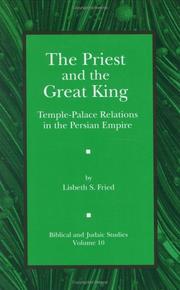| Listing 1 - 3 of 3 |
Sort by
|

ISBN: 0748617566 0748617558 9780748617555 9780748617562 1474469590 Year: 2004 Publisher: Edinburgh Edinburgh University Press
Abstract | Keywords | Export | Availability | Bookmark
 Loading...
Loading...Choose an application
- Reference Manager
- EndNote
- RefWorks (Direct export to RefWorks)
This is a concise introduction to the history of the ancient Near East during the last millenium BC : Phoenicia, Palestine, the Neo-Assyrian and Neo-Babylonian empires, the Persian Achaemenid empire, the empire of Alexander, and the vast Persian Seleucid empire founded by Seleucus around 300 BC and defeated by Pompey for Rome in 64 BC. The book focuses on political history, on the sources and shifts of power and the individuals who wielded it. It also introduces the reader to the principal aspects of the religious, social and economic history of the region.
922.2 --- geschiedenis --- Mesopotamië --- Tweestromenland --- Assyrië --- Babylonië --- Hittieten --- Sumerië --- Perzië --- Alexander de Grote --- geschiedenis - Sumerië, Babylonië, Assyrië --- Iraq --- History --- Civilization --- Ancient history --- Assyria, Babylonia, Mesopotamia --- To 634 --- oudheid

ISBN: 1575060906 1575065509 Year: 2004 Volume: 10 Publisher: Winona Lake, Indiana : Eisenbrauns,
Abstract | Keywords | Export | Availability | Bookmark
 Loading...
Loading...Choose an application
- Reference Manager
- EndNote
- RefWorks (Direct export to RefWorks)
The wars that periodically engulfed the Levant in the fourth century temporarily pulled the ruling governors and satraps away from Judah, and during these times, the Judaean priesthood may have capitalized on the brief absence of Persian officials to mint coins, but they achieved their longed-for independence only much later, under the Maccabees."--Jacket. "Lisbeth S. Fried's study investigates the impact of Achaemenid rule on the political power of local priesthoods during the 6th-4th centuries B.C.E. Scholars typically assume that, as long as tribute was sent to Susa, the capital of the Achaemenid Empire, subject peoples remained autonomous. Fried's work challenges this assumption. She examines the inscriptions, coins, temple archives, and literary texts from Babylon, Egypt, Asia Minor, and Judah and concludes that there was no local autonomy. The only people with power in the Empire were Persians and their appointees. This was true for Judah as well. The High Priest had no real power; there was no theocracy.
935.5 --- 935.5 Geschiedenis van Perzië, Persepolis --- Geschiedenis van Perzië, Persepolis --- Religion and politics --- Temples --- Architecture --- Church architecture --- Religious institutions --- Political science --- Politics, Practical --- Politics and religion --- Religion --- Religions --- History --- Religious aspects --- Political aspects --- Iran --- Politics and government. --- Religious architecture --- Middle East. --- Iran. --- Politics and government
Book
ISBN: 9054666455 9789054666455 Year: 2004 Publisher: Roeselare,
Abstract | Keywords | Export | Availability | Bookmark
 Loading...
Loading...Choose an application
- Reference Manager
- EndNote
- RefWorks (Direct export to RefWorks)
Van oermens tot cultuurmens - De Egyptenaren - Babyloniërs en Assyriërs - Hittieten en Syrische volkeren - Meden en Persen - De Egeïsche cultuur - De Grieken - Perikle - Broederoorlog - De eerste bloei van de wetenschap - Attische komedie - Macedonië - Hellinistische tijd - Etrusken; Romes sagentijd
History --- prehistorie --- Prehistory --- Antiquity --- #gsdb8 --- geschiedenis --- wereldgeschiedenis --- 903 --- 921 --- 922 --- 923 --- Perzië --- Romeinse rijk --- klassieke oudheid --- oudheid --- 920 --- Egypte --- Geschiedenis --- Griekenland --- Prehistorie --- Rome --- 930 ) * ALGEMENE GESCHIEDENIS --- Assyriërs --- Babyloniërs --- Egeïsche cultuur --- Egyptenaren --- Etrusken --- Grieken --- Hellenistische tijd --- Hittieten --- Macedonië --- Meden --- Perzen --- Syrische volkeren --- sagentijd --- algemene geschiedenis --- prehistorie, Atlantis --- geschiedenis - oudheid, Oosterse oudheid --- geschiedenis - klassieke oudheid --- Geschiedenis van tijdperken; afzonderlijk --- Auxiliary works --- History of medicine --- Dictionaries, encyclopedias, glossaries --- General, methodology --- Ancient & primitive --- Dictionaries, encyclopedias, glossaries. --- General, methodology. --- Ancient & primitive.
| Listing 1 - 3 of 3 |
Sort by
|

 Search
Search Feedback
Feedback About UniCat
About UniCat  Help
Help News
News